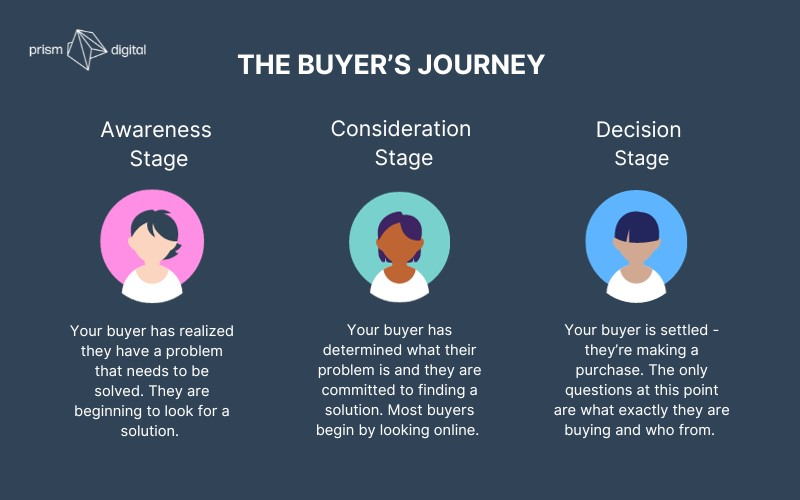What is the consideration stage of the buyer’s journey?

The consideration stage of the buyer's journey is a critical phase where potential customers are actively evaluating their options. During this stage, they seek in-depth information and solutions to address their specific needs and pain points. For your business, understanding how to create effective consideration stage content is essential for guiding prospects towards making informed decisions. In this blog post, we'll explore some examples of good consideration stage content that can help your audience move closer to conversion.
1. Comprehensive product guides:
By crafting detailed guides that delve into the features, benefits, and use cases of your products or services, you can demonstrate how your offerings solve specific problems. In these guides, try to include real-world examples, case studies, and testimonials, so you can provide prospects with the information they need to make an informed purchase decision.
Watch this example from Microsoft, as they delve into how users can grow their customer base using Microsoft 365 for business.
2. In-depth blog posts:
Informative and well-researched blog posts can be used to address common industry challenges or topics of interest to your target audience. These posts should explore various aspects of the issues at hand, providing valuable insights and potential solutions. In order to build credibility, you can incorporate data, statistics, and expert opinions.
Checkout HubSpot’s recent blog post, where they share how to write a LinkedIn summary—complete with examples of what NOT to do!
3. Comparison content:
Comparison articles, charts, or infographics can enable you to juxtapose your products or services with those of competitors. Think about how you can highlight key differentiators, advantages, and disadvantages. Transparency and objectivity are essential in this type of content.
In this article, La-Z-Boy takes an in-depth look at seven key differences between themselves and a competitor: Ashley Furniture.
4. Case studies and success stories:
Showcasing real-life success stories and case studies featuring your satisfied customers can help prospects visualize the potential outcomes of working with your business. When compiling a case study, be sure to highlight the specific challenges they faced, the solutions you provided, and the measurable results achieved.
Take a look at Inoxoft’s Case Study Page, where they share case studies from companies with similar challenges and how they turned them into advanced solutions.
5. Webinars and workshops:
Hosting webinars or virtual workshops allow your business to deep dive into relevant topics within your industry. Try inviting guest speakers or subject-matter experts to provide valuable insights and engage your audience in interactive discussions.
Check out Semrush’s recent webinar, which positions their organization as a thought leader.
6. Whitepapers and eBooks:
Informative whitepapers or eBooks can be developed in order to explore industry trends, best practices, or emerging technologies. These downloadable resources should be well-researched and offer in-depth knowledge to assist prospects in their decision-making process.
Take a look at Change Healthcare’s website, where they provide insight into the latest healthcare technology trends, guidance, and perspectives from prominent industry experts.
7. Interactive Content:
By engaging your audience with interactive tools like calculators, quizzes, or self-assessment surveys, you can help prospects evaluate their specific needs and requirements, guiding them towards tailored solutions.
Skin and Me do this by offering a free online consultation, so that their Dermatology Team can create a personalized skin treatment for potential customers.
8. Video Tutorials and Demos:
Video content can be created to provide step-by-step tutorials or product/service demonstrations. Visual guides are highly effective in helping prospects understand how your offerings work and how they can benefit from them.
This product demo packs a powerful punch with visuals of SurveyMonkey’s benefits and features as well as a walk-through of the product interface.
9. Expert Interviews:
Conducting interviews with industry experts, including members of your team, provides valuable insights and opinions on relevant topics.
See how Groove HQ establishes authority and trust with their audience by interviewing entrepreneur and marketing guru, Niel Patel.
10. Customer reviews and ratings:
By encouraging satisfied customers to leave reviews and ratings on platforms like Google, Yelp, or industry-specific directories, you can positively influence prospects' decisions and build credibility.
A final thought
Incorporating these examples of good consideration stage content into your digital marketing strategy can help you nurture leads, build trust, and guide prospects towards making well-informed decisions. By providing valuable and relevant information, you can position your agency as a trusted partner in solving your audience's challenges.
.png?width=200&height=73&name=Logo(1).png)


